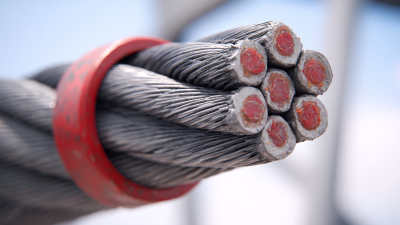In an era where energy reliability and efficiency have become paramount, the significance of transfer switch solutions cannot be overstated. According to a recent report by Research and Markets, the global market for transfer switches is expected to grow from $1.99 billion in 2021 to $3.38 billion by 2026, representing a compound annual growth rate (CAGR) of 11.2%. As organizations seek to enhance their operational capabilities and minimize downtime, effectively integrating transfer switch technology is pivotal. These devices not only ensure seamless power transitions during outages but also optimize energy management in both commercial and industrial sectors. This blog delves into top strategies for maximizing efficiency with transfer switch solutions, exploring how these innovations can propel businesses forward in a competitive landscape.

Transfer switch solutions are crucial for ensuring a seamless transition between power sources, especially during outages or maintenance. These devices automatically switch the load from the primary power source to a backup generator, providing uninterrupted electricity to critical loads. Understanding the core concepts behind transfer switches, including their types—manual and automatic, as well as their configurations, is essential for optimizing energy management in both residential and commercial settings.
The benefits of employing transfer switch solutions are significant. They enhance safety by preventing backfeed into the grid, which can endanger utility workers and damage equipment. In addition, they provide peace of mind, knowing that power will remain consistent during emergencies. Furthermore, these solutions can contribute to overall energy efficiency, as they allow for a better integration of renewable energy sources with existing power systems. By mastering these concepts, organizations and homeowners alike can maximize their efficiency and ensure reliable energy supply when it's needed the most.
In the pursuit of maximizing efficiency, exploring alternatives to conventional transfer switches can prove advantageous for both operational resilience and energy savings. Traditional transfer switches, while reliable, often introduce inefficiencies that can hamper overall performance. A recent report by the Electric Power Research Institute indicates that upgrading to advanced transfer switch solutions can enhance system efficiency by up to 30%. These modern alternatives are not only optimized for quicker response times but also integrate seamlessly with smart grid technologies, facilitating real-time monitoring and improved load management.
**Tip:** Consider implementing automatic transfer switches (ATS) that allow for a smoother transition between power sources, minimizing downtime and improving system stability.
Furthermore, options like hybrid transfer switches are gaining traction, combining the best features of traditional and modern technologies. According to the International Energy Agency, incorporating hybrid systems can reduce energy waste by approximately 20%, as they are designed to manage power distribution more effectively. By adopting these innovative solutions, organizations can mitigate risks associated with power outages while achieving significant operational cost reductions.
**Tip:** Regular maintenance and performance audits of transfer switch systems can pinpoint inefficiencies and ensure optimal functionality, extending the lifespan of the equipment.
In today's fast-paced world, the integration of smart technology with transfer switch solutions has become crucial for enhancing operational efficiency. Smart transfer switches are equipped with advanced communication and monitoring capabilities, allowing real-time data analysis and decision-making. By leveraging IoT technology, these systems can automatically detect power outages and seamlessly transfer power to backup sources, minimizing downtime and ensuring that critical functions remain operational.

Moreover, smart transfer switches can be integrated into broader energy management systems. This integration provides facilities with insights into their energy consumption patterns, enabling them to optimize usage and reduce costs. Audit trails and performance metrics produced by these intelligent switches help organizations make informed decisions regarding their energy strategies, facilitating smarter resource allocation and maintenance planning. As businesses continue to prioritize reliability and efficiency, the adoption of smart transfer switch solutions presents an opportunity to not only safeguard operations but also to enhance overall energy management practices.
When evaluating the cost-benefit analysis of different transfer switch alternatives, it becomes crucial to consider how these systems align with broader climate adaptation strategies and technological advancements.
The incorporation of hybrid solutions, similar to those being adopted in coastal defense and renewable energy systems, illustrates the potential for enhanced performance and risk reduction. Transfer switches, which facilitate the seamless transition between power sources, can benefit significantly from hybrid configurations that integrate both traditional and renewable energy technologies, optimizing operational efficiency while also mitigating climate-related risks.
Moreover, the economic aspects of transfer switch solutions are greatly influenced by evolving energy storage technologies. The integration of energy storage not only supports the reliable operation of transfer switches but also enhances their cost-effectiveness in the long run. As demonstrated in recent studies of managed aquifer recharge options and renewable energy systems, understanding the underlying costs and benefits is essential for making informed decisions.
By analyzing the efficiency and financial implications of various transfer switch alternatives, businesses can ensure they adopt the most sustainable and economically viable solutions in today's dynamic energy landscape.
Implementing effective transfer switch strategies is essential for maximizing efficiency in any electrical system. One of the best practices involves choosing the right type of transfer switch for your specific application, whether it be automatic or manual.
 Automatic transfer switches (ATS) provide seamless transitions to backup power, significantly reducing downtime during outages. In contrast, manual switches might be more cost-effective for less critical applications but require personnel to be present to activate. Analyzing the unique needs of your facility will guide you in selecting the most suitable option.
Automatic transfer switches (ATS) provide seamless transitions to backup power, significantly reducing downtime during outages. In contrast, manual switches might be more cost-effective for less critical applications but require personnel to be present to activate. Analyzing the unique needs of your facility will guide you in selecting the most suitable option.
Another crucial practice is regular maintenance and testing of your transfer switch systems. Routine inspections ensure that all components function correctly and can mitigate the risk of failure during a power outage. Implementing a structured testing schedule can help identify issues before they result in costly downtime or equipment damage. Additionally, training staff on operational procedures and safety protocols related to transfer switches enhances preparedness, ensuring quick and effective responses when power interruptions occur. By prioritizing these best practices, organizations can significantly enhance their overall operational resilience.



